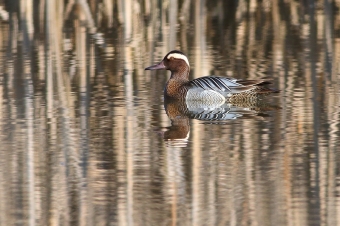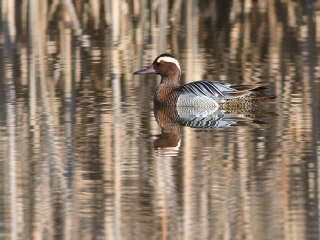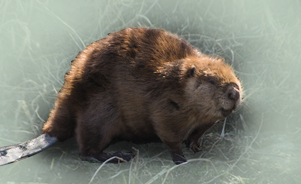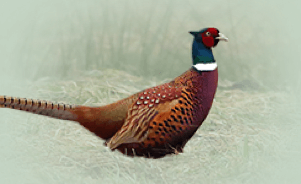Garganey Anas querquedula

Features
The garganey belongs to smaller ducks that can be spotted in Slovenia. From the tip of the beak to the end of the tail it measures from 37 to 41 cm; its wingspan is from 59 to 67 cm.
| Species | Bird |
| Living space | Lake, Rivers |
| Size | 37 - 41 cm |
| Weight | 330 g |
Description
From spring to summer, the garganey male is recognisable by the clear white stripe on its dark-brown head. This white 'eyebrow' goes above the eyes through the temples deep down to its nape and narrows towards the end. Its face, neck and chest are dark-brown with a pattern of thin white lines. Its abdomen and hips are pale grey with a dark marbled pattern, and the back of the body and the tail are brownish-grey and sprinkled with darker spots. What adds to the sophistication of its looks are the pointed, black and white outer flying feathers and a dark-grey beak. After nesting, the males change the feathers and become very similar to females. Much like the other ducks, the female is protectively coloured. Brown grainy feathers allow it to remain unnoticed when laying its eggs. The garganey female is characterised by a long, completely grey and relatively strong beak and a bright spot next to it. It has a dark line across its eyes, and a light one running above it. The garganeys look for food in the daytime and at night. During the nesting period, they are omnivorous, yet most of their diet consists of animals at that time. They mainly feed on water insects, especially larvae, and they like crayfish, leeches and frogs' progeny. This food is supplemented with various parts of aquatic and riparian plants. After nesting, the garganey feeds on the food of plant origin (seeds). The garganeys are remarkable migrants, leaving cold breeding areas and migrating to the south. They prefer to spend winters in large flocks on large inland lakes with freshwater or brackish water, rich in water and riparian vegetation, and also rests on rivers and floodplains, on shallow reservoirs and in salt-pans. They return to the breeding areas between mid-March and May. They prefer nesting in floodplain meadows along small shallow lakes, which are overgrown by dense aquatic and riparian vegetation. They hide their nests in patches of grass or sedge along lake shores.
Features Temenica (3)
SPECIAL ogr.




